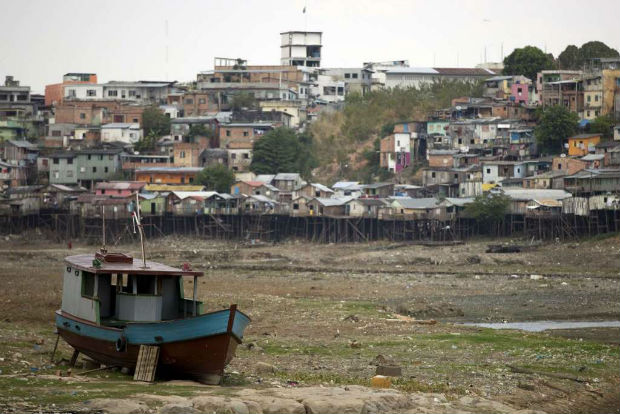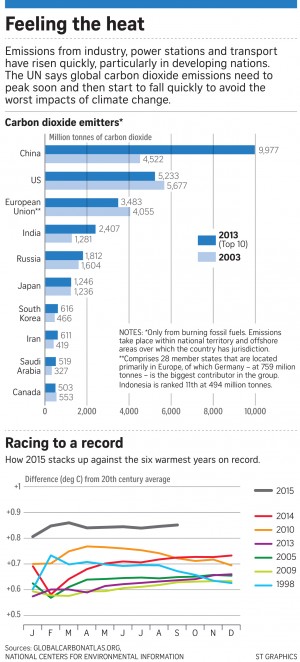Rising perils of climate change

A boat lying at the bottom of a branch of dried-up Rio Negro, a tributary of Amazon River. AGENCE FRANCE-PRESSE
SINGAPORE — The weather has been breaking new records, with this year expected to be the warmest on record. July, August and September have been the hottest months since modern records began.
Last week, Hurricane Patricia, one of the most powerful storms recorded, slammed into northern Mexico. Earlier this month, record floods hit the US state of South Carolina.
As extremes grow, everyone will be affected, from the poorest in Africa and India to those in well-off cities such as Singapore, New York and Hong Kong.
Climate change threatens the world’s food and water supplies, cities and coastlines. Sea levels are rising as the oceans become warmer, dramatically increasing the odds for storms.
Warmer and more acidic oceans are also damaging reefs and fish stocks.
Article continues after this advertisementGlobally, the weather is becoming more prone to extreme droughts, floods and storms. Growing crops, catching enough fish and keeping reservoirs full are proving more challenging every year.
Article continues after this advertisementIn Paris, nearly 200 nations will meet from Nov. 30 to Dec. 11 to try to agree on the final shape of a global pact to curb the pace of climate change.
Ultimately, the pact is about cutting greenhouse gas emissions, chiefly carbon dioxide (CO2) from burning fossil fuels in cars, power stations and industry. CO2 builds up in the atmosphere and oceans, trapping extra heat that is fueling wilder weather.
Doing a deal is urgent and long overdue after previous efforts failed to deliver a pact that brings all nations on board.
“It’s late. It may already be too late,” French President Francois Hollande told a recent gathering in Paris of high-ranking officials, scientists, business executives, NGOs and media.
“If no substantial measures are taken, we won’t be dealing with hundreds of thousands of refugees but millions over the next 20 or 30 years,” he said, in direct reference to the migrant crisis in Europe.
Everyone has to get on board.
“The agreement seeks to foster international cooperation and spur ambitious climate action by every country, big or small, developed or developing, as this is the best way to address the global challenge of climate change,” a spokesman for Singapore’s National Climate Change Secretariat (NCCS) told The Straits Times in an e-mail.
A study released this month by US intelligence agencies said climate change and extreme weather were among the threats to food availability in countries of strategic importance to the US over the next 10 years. Extreme weather was also a likely cause of social and political unrest.
“We judge that weather and climate patterns to 2025 will be key in determining local and regional crop production and will be a dominant factor contributing to the volatility of food prices,” said the report from the Office of the Director of National Intelligence.
Africa and Asia were the regions where food security would be most affected, the report said.
Reiterating the risks, US Secretary of State John Kerry said this month that global warming was the biggest threat to global food security.
Singapore is not immune and is vulnerable to rising sea levels, hotter temperatures and changes in rainfall patterns.
And, as a global trade hub, it can be affected by weather disasters outside, from the food it imports, such as seafood, to the materials manufacturing firms need to make their goods.
Climate change can also affect investments Singaporeans make in other countries.
A study led by Australian researchers and published this month warned of a collapse of global fish stocks. A combination of warming oceans, increased acidity, pollution and overfishing would reduce the diversity of marine species.
“There will be a species collapse from the top of the food chain down,” the study’s authors warned.
Rising seas from melting glaciers and polar ice caps threaten hundreds of millions of people along low-lying coastlines, from Manila to Miami, to Lagos and London.
According to an Indonesian government report, 42 million Indonesians living within 3km of the coast are vulnerable to rising sea levels.
In a study published on Oct. 13, researchers found steep cuts to emissions in the next decade are the only way to avoid substantial Antarctic ice loss and associated sea-level rise, The Guardian reported.
The study, published in the journal Nature, found that if global average temperatures rose by around 3 degrees C, this would trigger accelerating ice loss that would go on for thousands of years, raising sea levels by 0.6m to 3m by the year 2300, depending on how high man- made greenhouse gas emissions remain.
But if the rise in global average temperatures remains within 2 degrees C, ice loss can be minimized.
Animals will suffer too, with many forced to move to cooler areas or unable to hunt, such as polar bears, which rely on vanishing sea ice in the Arctic to catch seals and other prey.
The Arctic is warming twice as fast as the rest of the planet.
The world, though, is responding to the threat and more than 150 nations have made emissions reduction pledges ahead of the Paris talks – though these pledges commit the world warming by at least 3 degrees C, signaling that much more carbon belt-tightening is needed.

China is curbing coal use to tackle air pollution. China has invested heavily in hydro, wind and solar power and installed more renewable energy-generating capacity than any other nation.
India aims to build 100 gigawatts (GW) of solar capacity by 2022 from about 4GW now and has set a target of 60GW of installed wind power capacity by the same year.
Globally, wheat, rice, corn and other crops are being re-engineered to cope with droughts, heat and salinity. Such collective efforts are the only way the world will be able to both adapt to and rein in the accelerating pace of climate change.
“No country is immune to the effects of climate change and no country can deal with it on its own,” the NCCS spokesman said.
RELATED STORIES
Carbon Majors: primary drivers of climate change identified
Catholics mobilize for Pope’s encyclical on climate change